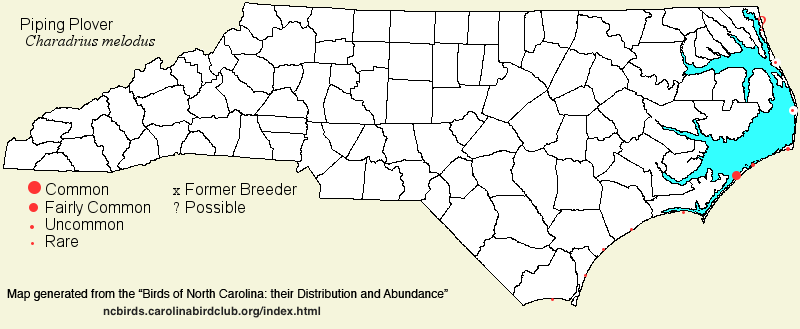 |  |
|
Piping Plover - Charadrius melodus CHARADRIIDAE Members: | Search Common: Search Scientific: |
|
|
|||||||
| General Comments | The Piping Plover is one of the few Federally listed birds in North Carolina, especially now that the Peregrine Falcon and Bald Eagle have been taken off the Endangered Species List. The Atlantic coast population is Federally Threatened, whereas the interior breeding population is Federally Endangered. North Carolina is the only state on the Atlantic coast where the breeding range overlaps with the wintering range. Color-banding of birds on the breeding ground has shown that most of the birds that winter in the state are Atlantic coast birds; however, some wintering birds are from the interior population. Thus, it is basically correct saying that the Piping Plover is Federally Threatened in North Carolina, but that some "Endangered" birds do winter, at least to some extent. The species has essentially the same habitats in the state as the Wilson's Plover; it breeds on sand flats, mainly near inlets or overwash areas, and it forages mostly on sand flats and on sandy shores, though usually not at the ocean edge. It very rarely is seen inland (almost always on mudflats at reservoirs), even though some birds from the interior certainly migrate over the mountains, Piedmont, and inland parts of the Coastal Plain. | ||||||
| Breeding Status | Breeder | ||||||
| NC BRC List | Definitive | ||||||
| State Status | T | ||||||
| U.S. Status | T | ||||||
| State Rank | S1B,S1N | ||||||
| Global Rank | G3 | ||||||
| Coastal Plain | Breeding permanent resident, with migratory movements, along the coast. Generally uncommon and declining, though the numbers have leveled off in the past few years at 40-60 pairs, due in part to human-intervention/protection of nesting pairs, mainly north of the state. An uncommon nester along the entire coast, though most pairs are on Core Banks, but a few nest south to Lea/Hutaff islands (Pender) and sporadically even south in Brunswick. Nesting on Hatteras Island has declined considerably over the past few decades. Winters along most of the coast, where uncommon throughout, and birds tend to be clustered in a few key areas, such as Bird Shoal at Beaufort. Can be locally fairly common in fall, such as at Bird Shoal and at Portsmouth Island. Away from the coast, practically casual/accidental in the province; one, Woodlake (Moore), 9 Sep 1977; one at New Bern, 7 Aug 1994; and one, at the northern end of Roanoke Island (Dare), 25 Aug 2022. Peak counts: 128, Core Banks, 29 Aug 1992; 117, Portsmouth Island, 18 Aug 2009; peak in winter: 100, Bird Shoal, 20 Dec 1973. | ||||||
| Piedmont | Transient. Very rare in fall; late July to early Oct; just one spring record. About 16 records, mostly from Falls and Jordan lakes, but three records from Guilford and two from Mecklenburg. The sole spring record is one photographed at Jordan Lake (Chatham) on 9 May 2025. Peak counts: 3, Jordan Lake, 14 Aug 1988. | ||||||
| Mountains | Casual, with just five records: one at Hooper Lane, Henderson on 4-5 Sep 2012* [Chat 77:6-10 link], [Chat 77:23 link]; one at that site from 12-15 Aug 2017 [Chat 82:32 link]; one near Brevard (Transylvania) on 16 May 2018 [Chat 82:87 link]; one at Hooper Lane on 15 Apr 2020 [Chat 84:93 link]; and one at that last site on 28 Apr 2023. | ||||||
| Finding Tips |
The best area to see this species is at Portsmouth Island in late summer and fall, but a boat is necessary to reach the site. Other good areas are at Cape Hatteras Point (except in winter), at the north and south ends of Ocracoke Island, at Bird Shoal (in the fall and winter), and at the north end of Wrightsville Beach; however, a boat is needed to visit Bird Shoal. Plover nesting areas are sometimes closed during the breeding season, so please do not enter these posted areas. Because beach habitat that this species prefers can change dramatically in a short time, areas occupied by Piping Plovers may change every few years. ** to *** | ||||||
| Attribution | LeGrand[2025-07-23], LeGrand[2024-10-24], LeGrand[2024-02-10] | ||||||
| NC Map Map depicts all counties with a report (transient or resident) for the species. | Click on county for list of all known species. |
| NC Breeding Season Map Map depicts assumed breeding season abundance for the species. |  |